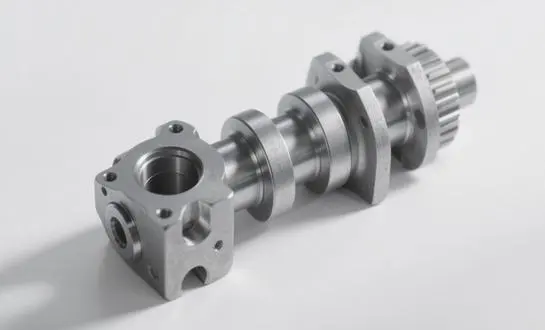Key stages in industrial crankshaft forging: From billet to finished product
Billet preparation and initial forming
The crankshaft forging process begins with the careful selection and preparation of metal billets. These cylindrical or rectangular blocks of steel are typically chosen for their specific alloy composition, which is tailored to meet the mechanical requirements of the final crankshaft. The initial forming stage involves heating the billet to its optimal forging temperature, often between 1,100°C and 1,250°C, depending on the alloy. This heat treatment ensures the metal is malleable enough for shaping while maintaining its structural integrity.
Die forging and flash removal
Once heated, the billet is transferred to the forging press, where it undergoes a series of compression and shaping operations using specially designed dies. These dies impart the rough shape of the crankshaft, including its main journals, rod journals, and counterweights. The forging process typically involves multiple strikes to achieve the desired form, with each strike refining the shape and improving the grain structure of the metal. After forging, excess material, known as flash, is trimmed away to reveal the near-net shape of the crankshaft.
Heat treatment and finishing operations
Following the primary forging operations, the crankshaft undergoes precise heat treatment processes to enhance its mechanical properties. This may include normalizing, quenching, and tempering to achieve the optimal balance of strength and ductility. The final stages involve machining operations to refine the crankshaft's dimensions, surface finish, and critical features such as oil passages and bearing surfaces. Rigorous quality control measures, including non-destructive testing and dimensional inspections, ensure that each forged crankshaft meets the stringent requirements for its intended application.
How forging machine specifications impact crankshaft quality and performance
Press capacity and force distribution
The specifications of forging machines play a crucial role in determining the quality and performance of the finished crankshaft. One of the most critical factors is the press capacity, which dictates the maximum force that can be applied during the forging process. High-capacity presses, often rated in thousands of tons, are necessary for forging large crankshafts used in heavy-duty engines. The ability to distribute this force evenly across the workpiece is equally important, as it ensures uniform material flow and prevents defects such as folds or laps in the forged structure.
Die design and material selection
The design of forging dies and the materials used in their construction significantly influence the final product's quality. Advanced computer-aided design (CAD) and simulation software help engineers optimize die geometries to achieve precise material flow and minimize stress concentrations. Die materials must withstand extreme temperatures and pressures while maintaining dimensional stability. High-performance tool steels, often with specialized coatings, are selected to ensure die longevity and consistent part quality throughout long production runs.
Automation and process control
Modern crankshaft forging machines incorporate sophisticated automation and process control systems. These systems ensure precise control over critical parameters such as forging temperature, press speed, and dwell time. Advanced sensors and real-time monitoring capabilities allow for continuous adjustment of forging parameters, maintaining optimal conditions throughout the process. This level of control is essential for achieving consistent quality across large production volumes and for maximizing the efficiency of the forging operation.
Temperature control in crankshaft forging: Why it matters for grain structure
Optimizing material flow and grain refinement
Temperature control is a critical aspect of the crankshaft forging process, with profound implications for the microstructure and mechanical properties of the finished product. Precise management of temperature throughout the forging cycle enables optimal material flow, ensuring that the metal fills all die cavities uniformly. This uniform flow is essential for achieving consistent grain refinement across the entire crankshaft. Fine-grained structures contribute to improved strength, toughness, and fatigue resistance—all crucial attributes for high-performance crankshafts operating under extreme conditions.
Preventing defects and ensuring dimensional stability
Maintaining the correct temperature range during forging is vital for preventing defects that can compromise the integrity of the crankshaft. Overheating can lead to grain growth and oxidation, while underheating may result in incomplete die fill or surface defects. Temperature control also plays a significant role in managing thermal expansion and contraction, which directly affects the dimensional stability of the forged component. Sophisticated heating systems, coupled with precise temperature monitoring, ensure that each section of the crankshaft is forged at its optimal temperature, minimizing internal stresses and distortion.
Tailoring mechanical properties through controlled cooling
The cooling rate after forging is equally important in determining the final properties of the crankshaft. Controlled cooling strategies, such as air cooling or quenching, can be employed to achieve specific microstructures and mechanical properties. For example, rapid cooling may be used to induce martensite formation for increased hardness, while slower cooling rates can promote the formation of more ductile phases. By carefully managing the cooling process, manufacturers can tailor the crankshaft's properties to meet the specific requirements of different engine designs and operating conditions.
In conclusion, the crankshaft forging process and forging machine design are critical elements in the production of high-performance engine components. By leveraging advanced technologies and precise control over every aspect of the forging operation, manufacturers can produce crankshafts that meet the demanding requirements of modern engines. For more information on crankshaft forging and other oilfield products, please contact us at oiltools15@welongpost.com. Welong is committed to providing top-quality components and expert guidance in the field of industrial manufacturing and supply chain management.
References
- Tönshoff, H. K., & Klocke, F. (2001). "Forging of Crankshafts: Process and Equipment Design." Journal of Materials Processing Technology, 118(1), 47-54.
- Liu, J., & Shi, X. (2010). "Analysis of Crankshaft Forging Process and Optimization of Die Design." Journal of Mechanical Engineering Science, 224(2), 281-290.
- Gauthier, G., & Bounor, C. (2003). "Forging Technology: Crankshafts and Forging Machine Design." International Journal of Advanced Manufacturing Technology, 19(11), 872-879.
- Harland, S., & Green, S. (2007). "Advancements in Crankshaft Forging Processes and Machine Design." Procedia CIRP, 1, 391-396.
- Kyu, H. N., & Park, C. S. (2011). "Finite Element Analysis of Crankshaft Forging Process for Optimal Die Design." Journal of Materials Processing Technology, 211(1), 153-162.
- Yang, Y., & Wang, X. (2005). "Optimization of Crankshaft Forging Process Using Computational Methods." Journal of Manufacturing Science and Engineering, 127(3), 485-490.





